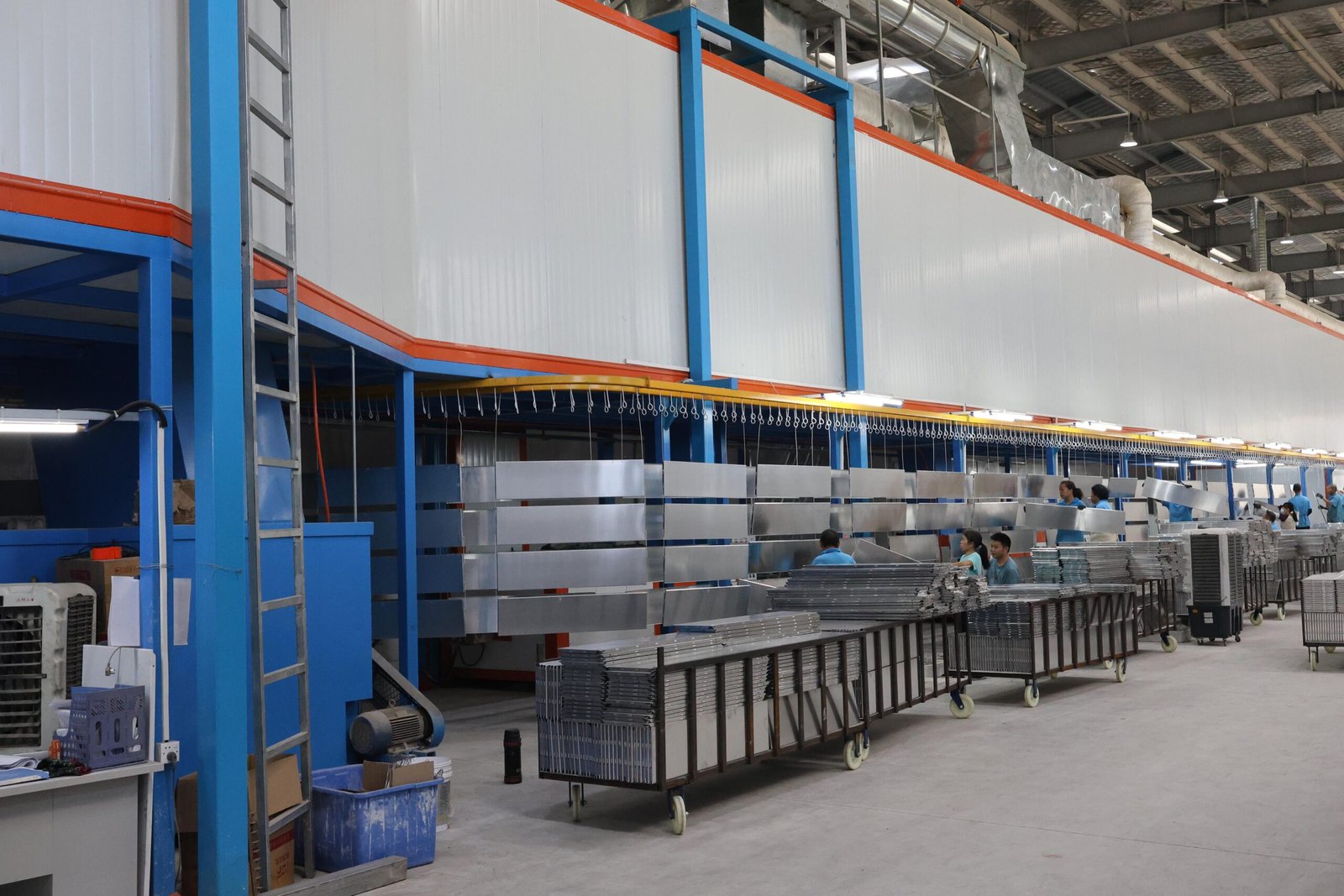What Are Common Problems Encountered in Powder Coating Production Lines?

Powder coating looks simple—but problems like orange peel and uneven color tell a different story.
If left unchecked, they ruin batches and hurt reputation.
Common problems in powder coating production lines include inconsistent thickness, poor adhesion, contamination, curing defects, orange peel, Faraday cage effect, and equipment failure. Each issue has identifiable causes and proven solutions.
Want a smoother process and fewer rejected parts? Let’s go through each issue—and how to fix it.
Why does coating thickness vary in powder coating?

Some parts are glossy and thick. Others—thin, dull, or bare in spots.
That’s a big red flag for coating consistency.
Inconsistent coating thickness usually comes from incorrect gun settings, powder flow issues, or fluctuating electrostatic charge.
We fix this by regularly calibrating our equipment and checking flow meters and voltage readings.
Common Fixes
| Problem | Solution |
|---|---|
| Irregular powder feed | Check hopper level and vibrators |
| Inconsistent voltage output | Inspect power supply and ground contacts |
| Uneven gun-to-part distance | Train staff on steady motion patterns |
Regular coating thickness tests with magnetic gauges help catch problems early.
How does surface contamination affect coating quality?
If the metal isn't clean, the powder won’t stick.
And if it does, it’ll peel within days.
Surface contamination—oil, grease, moisture, or dust—prevents proper adhesion and leads to premature failure.
We always start with a rigorous pre-treatment process:
- Degreasing tanks or spray lines
- Rinse and deionized water stages
- Thorough drying before powder application
Keeping the powder booth and handling tools clean is just as important.
What causes curing issues in powder coating lines?

If the coating scratches too easily or turns yellow, chances are the oven is to blame.
Curing issues stem from inaccurate oven temperatures or incorrect dwell times, causing under- or over-curing.
To prevent this, we:
- Use thermocouples to measure part surface—not just air temp
- Follow the powder supplier’s cure schedule (e.g., 200°C for 10 minutes)
- Regularly calibrate our curing ovens
Tip: Always test a few panels per batch with solvent rub or adhesion tests.
What is the orange peel effect—and how do you fix it?
Ever seen a bumpy finish that looks like citrus skin?
That’s orange peel—and it screams poor technique.
Orange peel happens due to high film builds, improper gun settings, or powder formulation mismatch.
We reduce orange peel by:
- Lowering powder output to avoid overloading
- Keeping spray distance consistent
- Using smooth-flowing powders with proper particle size
For high-gloss parts, we always test spray samples before full runs.
What is the Faraday cage effect in powder coating?
Recessed corners and deep cavities often end up undercoated.
That’s the Faraday cage effect in action.
The Faraday cage effect occurs when the electrostatic field blocks powder from entering tight areas.
We combat it using:
- Lower voltage settings at edges and corners
- Extended dwell times in recessed spots
- Special nozzles for penetrating airflow
For complex parts, we sometimes pre-coat the corners by hand before the automatic booth run.
Why does color vary between parts or batches?
Inconsistent color looks cheap—even if the coating is strong.
Color variation can be caused by poor powder mixing, contamination, or inconsistent oven temps.
We maintain color consistency by:
- Using the same powder batch for full orders
- Blending powders with a sieve before use
- Checking spray thickness, as thicker coats can shift color
We also store powder in climate-controlled rooms to prevent degradation.
What causes powder spitting or clumping?
You’re spraying. Suddenly—splat! Clumps hit the part.
Now you’re sanding and starting over.
Spitting and clumping result from moisture in powder, clogged hoses, or worn spray gun parts.
To stop this:
- We keep powders sealed in dry areas
- Install inline desiccant dryers at air inputs
- Inspect guns weekly for nozzle or electrode build-up
Humidity control is especially crucial during summer months.
What causes poor adhesion in powder coatings?
If the coating flakes off with a simple knife scratch, it never bonded.
Poor adhesion is usually a result of bad pre-treatment, under-curing, or excessive film thickness.
We run adhesion tests regularly—especially after line changes.
How we ensure adhesion:
- Maintain clean surfaces with proper chemical pretreatment
- Follow exact cure schedules for each powder
- Use proper grounding to attract charged particles effectively
Training staff to identify signs of poor adhesion helps avoid rework.
How do environmental factors impact powder coating?
Hot, cold, or humid environments affect more than comfort—they affect quality.
Temperature and humidity shifts change powder flow, static charge levels, and drying rates.
We stabilize conditions by:
- Using HVAC systems in booth and storage rooms
- Checking booth air pressure to avoid dust entry
- Avoiding powder use during extreme humidity
Even slight changes in environment can cause clumping, poor flow, or uneven cure.
Why is equipment maintenance so critical?
Even the best staff can’t work around a broken gun or faulty oven.
Dirty or uncalibrated equipment leads to all the issues above—from spitting powder to inconsistent curing.
Our checklist includes:
| Equipment | Maintenance Schedule |
|---|---|
| Spray guns | Clean daily |
| Booth filters | Replace weekly |
| Ovens (burners, fans) | Inspect monthly |
| Powder hoses | Check for clogs weekly |
Preventive maintenance pays for itself by reducing rework and downtime.
Conclusion
Every powder coating line faces problems—but most can be prevented with training, calibration, and clean work habits. Catching small issues before they become big ones is what separates a good shop from a great one.
